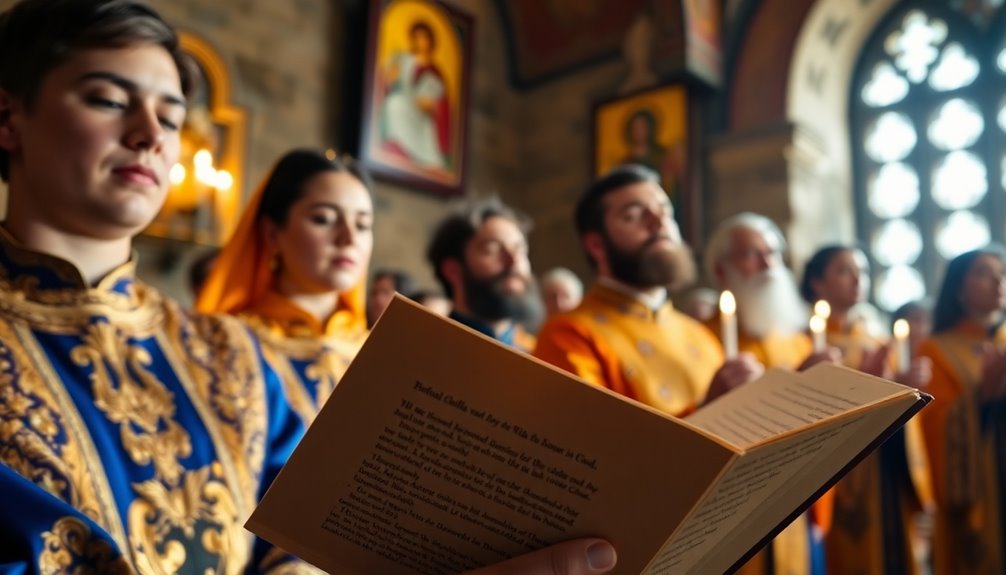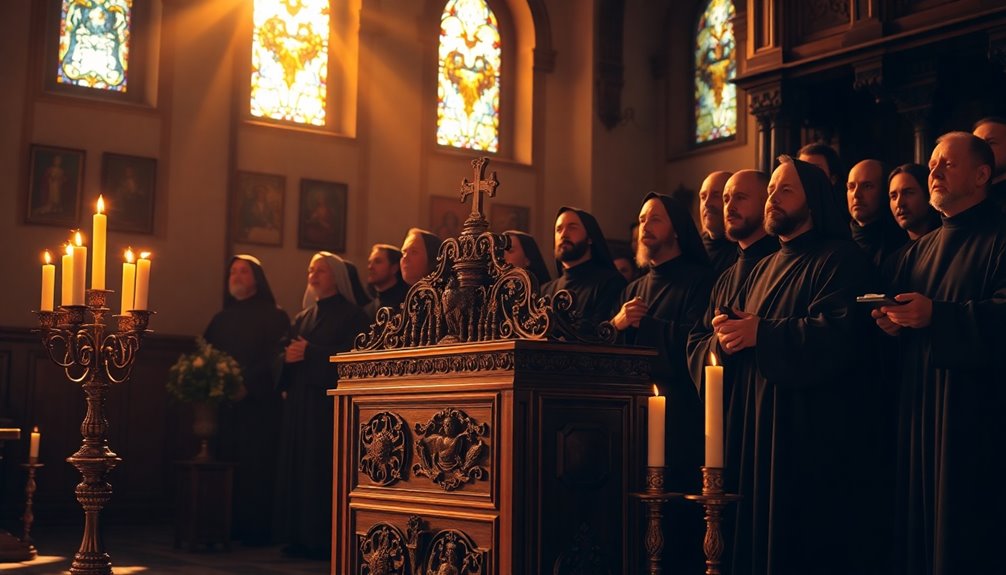An Orthodox troparion is a sacred hymn that plays an essential role in Orthodox Christian worship. It encapsulates theological themes and commemorates saints or feast days, enriching the liturgical experience. These hymns set the tone for services like Vespers and Divine Liturgy, inviting you to reflect on your faith. Each troparion carries a unique message of hope and unity, connecting you with the larger community. You'll discover even more about these inspiring hymns and their significance as you explore further.
Key Takeaways
- A troparion is a vital hymn in Orthodox worship that encapsulates theological themes and commemorates saints or feast days.
- The term "troparion" comes from the Greek word for "refrain," indicating its repetitive nature in liturgical services.
- Troparia have been part of Byzantine music since at least the 5th century, reflecting deep Orthodox traditions.
- Each troparion conveys a specific message about a saint's life or faith, fostering connection among believers.
- Troparia enhance worship by inviting reflection and engagement, enriching the spiritual experience of Orthodox Christians.

In Orthodox Christian worship, the troparion serves as an essential hymn that encapsulates theological themes and commemorates saints or feast days. These short hymns, known as troparia, are integral to the rhythm of the liturgical calendar. You'll notice them frequently during services like Vespers, Matins, and the Divine Liturgy, where they help establish the day's theme and create a spiritually enriching atmosphere.
The term "troparion" comes from the Greek word "tropos," which means something repeated—reflecting its role as a refrain or motif within the service. When you hear a troparion chanted, you're engaging with centuries of Orthodox tradition. These hymns have been part of Byzantine music since at least the 5th century, demonstrating how deeply rooted they're in the faith and its practices.
Among the troparia, the Theotokion holds a special place. These hymns are dedicated to the Mother of God, the Virgin Mary, and express profound respect and veneration. When you join in the singing of a Theotokion during worship, you're participating in a rich tradition that acknowledges Mary's unique role in salvation history. This becomes especially poignant during Holy Week, as troparia reflect the themes of Passion and Resurrection, guiding your spiritual journey through this significant period.
Each troparion carries its message, often summarizing the life of a saint or reflecting on the mysteries of the faith. You'll find that these hymns resonate with the everyday struggles and victories of Orthodox Christians. For many, singing or listening to troparia can evoke feelings of connection to the broader community of believers, both past and present. They serve as a reminder of the ultimate victory to the Orthodox through Christ's resurrection, reinforcing a sense of hope and unity.
As you participate in the Divine Liturgy or any other service, take a moment to absorb the meaning behind the troparia. Each hymn is a window into the faith, a call to remembrance, and an invitation to deepen your understanding. The rich tapestry of Orthodox worship is woven together by these sacred hymns, allowing you to engage not just with the words, but with the very essence of the faith itself.
Whether during Holy Week or any other time of the year, the troparion remains a significant expression of Orthodox spirituality.
Frequently Asked Questions
What Is an Orthodox Troparion?
An Orthodox troparion is a short hymn that plays a significant role in Greek Orthodox worship.
It's often recited or chanted during services like Vespers and the Divine Liturgy.
You'll notice that these hymns reflect key theological themes and the church calendar.
Troparia can vary, including those dedicated to the Virgin Mary or the Holy Trinity.
They've evolved over centuries, maintaining their importance in the liturgical practices of the Orthodox Church.
What Is the Difference Between a Troparion and a Kontakion?
Think of a troparion as a delicate whisper in a grand cathedral, while a kontakion is a resounding echo.
You'll find that a troparion is a short hymn, often focusing on a specific theme or saint, recited during services.
In contrast, a kontakion is longer and richer in theological content, typically sung in multiple stanzas.
Both play essential roles in Orthodox worship, but they serve different purposes and convey varying depths of meaning.
What Is the Difference Between Troparion and Apolytikion?
The difference between a troparion and an apolytikion is mainly in their purpose and use.
While every apolytikion is a type of troparion, not all troparia serve as apolytikia.
You'll find apolytikia used as dismissal hymns at the end of Vespers, setting the theme for the next day.
Troparia, on the other hand, can be sung throughout various services, addressing different saints or liturgical themes.
What Does Troparia Mean in English?
Troparia translates to "refrain" or "something repeated" in English, reflecting their role in worship.
Did you know that there are over 1,000 different troparia used in Orthodox services? These short hymns often commemorate specific saints or liturgical themes, enriching the worship experience.
You'll find them recited or chanted during services, making them an essential part of the Orthodox tradition. Their purpose is to deepen your connection to faith and community.
Conclusion
In exploring the beauty of the Orthodox Troparion, you're reminded of the power these sacred hymns hold in connecting us to our faith. Each troparion encapsulates deep emotions and profound truths, inviting you to reflect on your own spiritual journey. Isn't it incredible how a few carefully chosen words can resonate so deeply within our hearts? By embracing these hymns, you not only honor tradition but also enrich your soul, finding solace in their timeless melodies.









